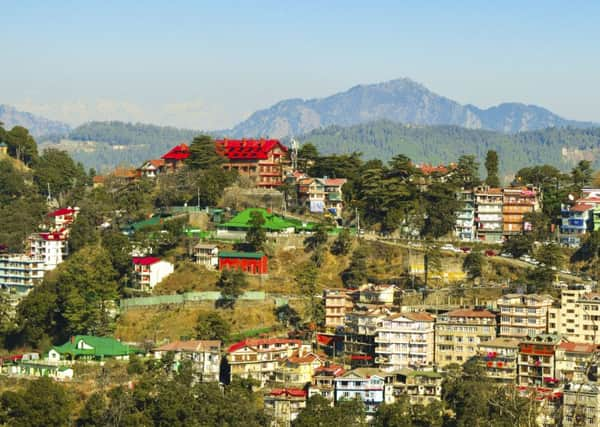Travel review: The slow train to Shimla


A century ago, Britishers visiting Shimla, the Himalayan hill station that became the summer capital of the Raj, generally got there in a dhooly, a sort of sedan chair carried by four porters.
As they toiled up the steep slopes, the porters chanted in Hindi. This always struck newly-arrived Brits as charmingly picturesque, until old-timers pointed out that the porters were chanting “When shall we tip out the big fat pigs?”
Advertisement
Hide AdAdvertisement
Hide AdRudyard Kipling, the author who once defined India for British readers, worked in Shimla as a young newspaper reporter. Instead of a dhooly, he usually travelled up by tonga, a trim horse-drawn carriage. As the roads climbed to 7,000 feet and he neared the town, some of them were, he wrote, “just ledges”.
There aren’t many dhoolies or tongas around these days. So my wife and I are travelling on the celebrated Toy Train, as it used to be called, as we head up to Shimla on Kipling’s trail. The 150th anniversary of his birth, in Bombay (now Mumbai) will be celebrated on December 30. And there’s a special Yorkshire reason to celebrate.
The Toy Train, a narrow-gauge railway that opened in 1903, now has World Heritage status. It’s ridiculously quaint, with each of its half-dozen boxy carriages seating 30 passengers. Exactly on time it edges out of Kalka station, 150 miles north of Delhi, with much hooting and tooting at the start of its 60-mile journey.
It’s a slow-motion switchback ride, a good five hours of viaducts, bridges (845 of them) and tunnels (much shrieking from the children on board). The line zigs and zags, double-backs and triple-backs, before we eventually emerge through the mists into sunshine, high enough to be flying.
Advertisement
Hide AdAdvertisement
Hide AdGradually Shimla unfolds in the distance, sprawling over the hillsides, houses clinging to the slopes by their fingernails, with vast snow-covered mountains behind. The sun sets behind the pine trees, the train pulls in, and we drive to our hotel, the ultra-plush Oberoi Cecil, where the house pianist is playing My Bonnie Lies Over the Ocean.
The hotel perches on a ridge and many rooms, including ours, offer sweeping views over the mountains. At night, the house and street lights far below stud the darkness – “a double firmament”, as Kipling wrote in his novel Kim.
The book is partly set in Shimla’s “rabbit warren of bazaars”. But the town’s colonial atmosphere is best captured in Kipling’s Plain Tales from the Hills, his poignant, satirical stories about the intrigue-filled claustrophobia of Raj life.
That staunchly British atmosphere lingers at the Gaiety Theatre, home of the town’s Amateur Dramatic Club (established 1837), where lounge suits must be worn after 7pm, though before then “decent jeans” are permitted.
Advertisement
Hide AdAdvertisement
Hide AdWe meet Raaja Bhasin, author of the standard history of Shimla, for coffee. “I feel we read Kipling too selectively, as an imperialist jingoist,” he says. “As long as he was in India, there was a great deal more sensitivity in the man.”
Even so: “The general attitude to him in today’s India is that it’s all part of history, that we should leave it at that and move on.”
He takes us down to the auditorium, a perfect pocket theatre seating around 300 and immaculately restored in green and gold where Kipling once acted in a farce. “Horrid and vulgar,” was the Viceroy’s crisp critique of his performance.
The Viceroy lived in the Vice-Regal Lodge, where his every need was met by 800 staff (including 40 gardeners). The old tiger-skin rugs are a fine contrast to the utilitarian metal shelving used by the Lodge’s present occupants, an academic institute. Outside, a gardener hurls stones at monkeys.
Advertisement
Hide AdAdvertisement
Hide AdShimla is now vastly bigger, busier and more chaotic than in Kipling’s time. It caters for crowds of Indian tourists, with souvenir shops and candy floss. But there are still reminders of the old days: the half-timbered shops and houses, the retired Indian colonels strolling in their royal blue blazers.
We eventually reach Christ Church, a primrose-yellow Cotswold church somehow left behind in the Himalayas.
As for Rudyard’s Kipling’s Yorkshire connections, Lockwood, his father, hailed from a line of Kiplings based at Lythe near Whitby. Born in Pickering, son of a Methodist minister, he was educated at a boarding school in Apperley Bridge near Bradford. Rudyard reckoned Lockwood had a “sage Yorkshire outlook and wisdom”. We naturally salute that judgement.
GETTING THERE
Cox & Kings (020 3642 0861, www.coxandkings.co.uk) offers Golden Triangle & Shimla, a 13-day/11-night escorted group tour from £1,795 pp, twin share. It includes international flights, airport transfers and 4 or 5 star half-board accommodation. It features a trip on the Toy Train to Shimla, three-nights at the Oberoi Cecil, and visits Delhi, Jaipur and Agra (for the Taj Mahal).
East Midlands Trains (www.eastmidlandstrains.co.uk) runs services from Leeds and Sheffield to London St Pancras (for Heathrow).